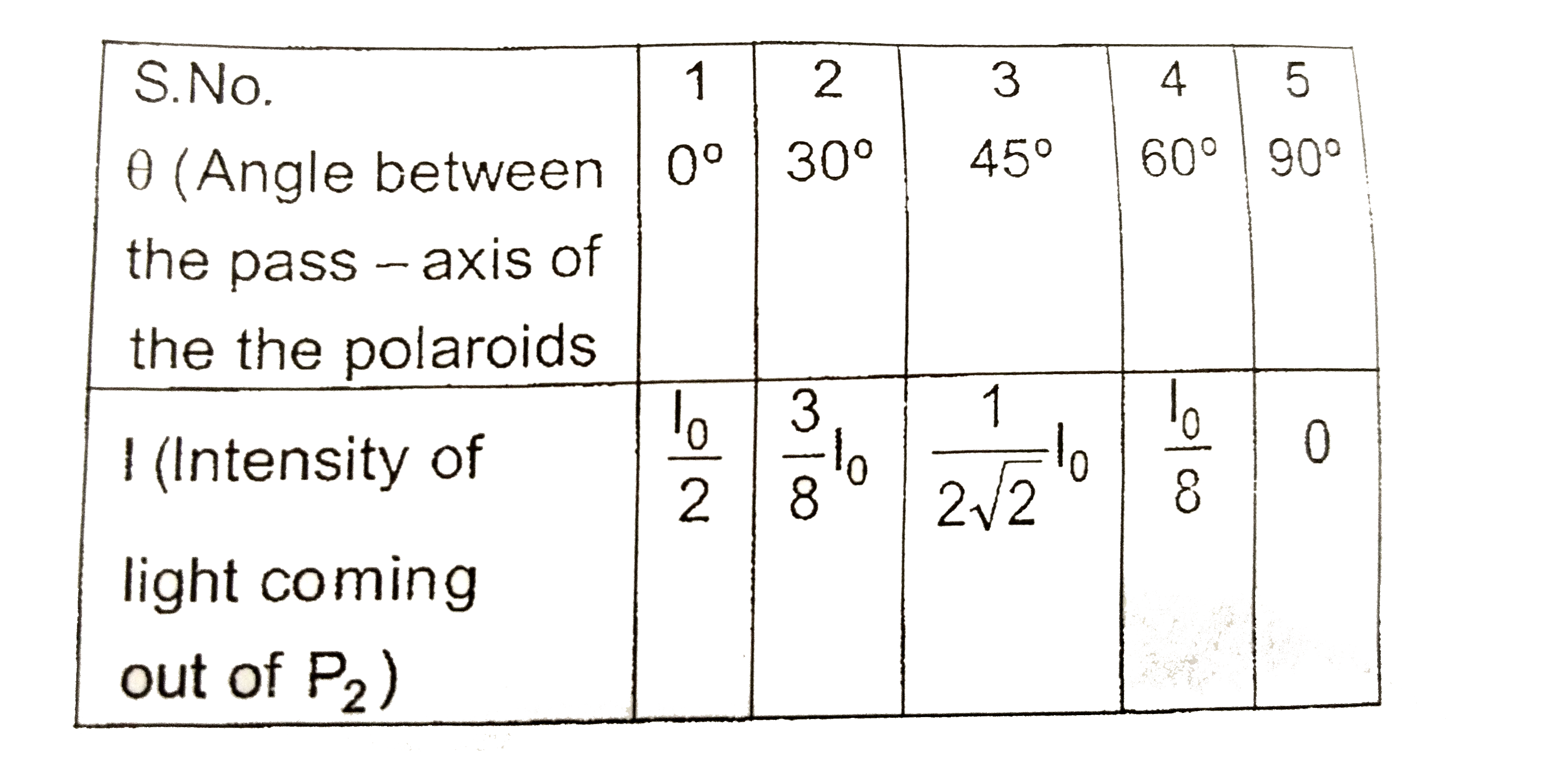Three indential polaroid sheets P1,P2 and P3 are oriented so that the pass axis of P2 and P3 are inclined at 60∘ and 90∘ resp. with respect to pass axis of P1. A monochromatic source of intensity I0 is Kept in front of the polaroid sheet P1. Find the intensity of this light as observed by O1,O2,O3 positioned as shown in Fig.

When unpolarised light passes through a polaroid, the intensity of transmitted light becomes half the intensity of unpolarised light.
∴ Intensity of light observed by O1 is
I1=I0/2
(ii) Now, angle between P1andP2 is θ=60∘.
∴ Intensity of light observed by O2 is
I2=I1cos260∘=I02(12)2=I08
(iii) Angle between P2andP3 is ltbr> θ=90∘−60∘=30∘.
∴ Intensity of light observed by O3 is
I3=I2cos230∘=I08(√32)2=3I032
Topper's Solved these Questions
- OPTICSBOOK - PRADEEPCHAPTER - OPTICSEXERCISE - Conceptual problems
9 Videos
- OPTICSBOOK - PRADEEPCHAPTER - OPTICSEXERCISE - Very short answer questions (Questions)
1 Videos
- OPTICSBOOK - PRADEEPCHAPTER - OPTICSEXERCISE - Sample Problem 6(e)
1 Videos
- MAGNETIC EFFECT OF CURRENT AND MAGNETISMBOOK - PRADEEPCHAPTER - MAGNETIC EFFECT OF CURRENT AND MAGNETISMEXERCISE - Competition Focus (Multiple Choice Questions)
2 Videos
Similar Questions
A system of three polarizers P1,P2,P3 is set up such that pass axis of P3 is crossed with respect to that of P1. The pass axis of P2 is inclined at 60∘ to the pass axis of P3. When a beam of unpolarized light of intensity I0 is incident on P1, the intensity of light transmitted by the three polarizes is I. The ratio (Io/I) equals (nearly) : a) 5.33 b) 16.00 c) 10.67 d) 1.80
View SolutionA system of three polarizers P1,P2,P3 is set up such that the pass axis of P3 is crossed with respect to that of P1. The pass axis of P2 is incined at 60∘ to the pass axis of P3. When a beam of unpolarized light of intensity I0 is incident on P1 the intensity of light transmitted by the three polarizes is I.The ratio (I0/I) equals (nearly):
View Solution
Knowledge Check
The polaroids P1,P2&P3 are arranged coaxially. The angle between P1 and P2 is 37∘. The angle between P2 and P3 is, if intensity of emerging light is a quarter of intensity of unploarized light
Aθ=cos−1(54)Bθ=cos−1(45)Cθ=cos−1(45√2)Dθ=cos−1(54√2)
Two polaroids P1andP2 are set up so that their pass axis are crossed with respect to each other. A third polaroid P3 is now introduced between these two so that its pass axis makes an angle θ with the pass axis of P1.
A beam of unpolarised light of intensity I0 is incident on P1. if the intensity of light, that gets transmitted through the combination of three polaroids, be I find the ratio II0 when θ equals.
(i) 30∘,
(ii) 45∘.
View SolutionUnpolarized light is intensity I0 passes through two polaroids P1 and P2 such that pass axis of P2 makes an angle θ with the pass axis of P1. A third polaroid P3 is placed between P1 and P2 with pass axis of P3 making an angle β with that of P1. If I1,I2,I3 represent intensities of light trnasmitted by P1,P2,P3, determine the values of angle θ and β for which I1=I2=I3.
View Solution(a) Light, from a sodium lamp, is passed through two polaroid sheets P1 and P2 kept one after the other. Keeping P1 fixed, P2 is rotated so the its 'pass-axis' can be at different angles, θ, with respect to the pass-axis of P1
An experimentalist records the following data for the intensity of light coming out P2 as a function of the angle θ.

[I0= Intensity of beam falling on P1]
One of these observation is not is agreement with expected theoretical variation of l. ldentify this observation and write the correct expression.
(b) Define Brewster angle and write the expression for it in terms of the refractive index of the medium.
View Solution(a) Light, from a sodium lamp, is passed through two polaroid sheets P1 and P2 kept one after the other. Keeping P1 fixed, P2 is rotated so the its 'pass-axis' can be at different angles, θ, with respect to the pass-axis of P1
An experimentalist records the following gata for the intesity of light coming out P2 as a function of the angle θ.

[I0= Intensity of beam falling on P1]
One of these observation is not is agreement with expected theoretical variation of l. ldentify this observation and write the correct expression.
(b) Define Brewster angle and write the expression for it in terms of the refractive index of the medium.
View SolutionTwo polaroids, P1andP2 are set-up so that their pass-axis crossed with respect to each other. A third polaroids, P3 is now introduces between these two so that its pass-axis makes and anlge θ with the pass-axis of P1.
A beam of unpolarised light, of intensity I, is incident on P1. If the intensity of light, that gets transmitted through this combination of three polaroids is I find the ratio (II) when θ equals.
(i)30∘ (ii)45∘
View SolutionTwo Polaroids, P1andP2 are set-up so that their pass-axis are crossed with respect to each other. A third Polaroids, P3 is now introduced between these two so that its pass-axis makes and angle θ with the pass-axis of P1.
A beam of unpolarised light, of intensity I, is incident on P1. If the intensity of light, that gets transmitted through this combination of three Polaroids is I' find the ratio (I'I) when θ equals.
(i)30∘ (ii)45∘
View Solution(a) Using the phenomenon of polarisation, show how transverse nature of light can be demonstrated.
(b) Two polaroids P1andP2 are placed with their pass axes perpendicular to each other. Unpolarised light of intensity I0 is incident on P1. a third polaroid P3 is kept in between P1 and P2 such that its pass axis makes an angle of 30∘ with that of P1. determine the intensity of light transmitted through P1,P2andP3.
View Solution
